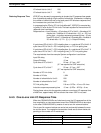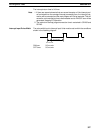
390
7-1 Monitoring Operation and Modifying Data
The simplest form of operation monitoring is to display the address whose oper-
and bit status is to be monitored using the Program Read or one of the search
operations. As long as the operation is performed in RUN or MONITOR mode,
the status of any bit displayed will be indicated.
This section provides other procedures for monitoring data as well as proce-
dures for modifying data that already exists in a data area. Data that can be mo-
dified includes the PV (present value) and SV (set value) for any timer or counter.
All monitor operations in this section can be performed in RUN, MONITOR, or
PROGRAM mode and can be cancelled by pressing CLR.
All data modification operations except for timer/counter SV changes are per-
formed after first performing one of the monitor operations. Data modification is
possible in either MONITOR or PROGRAM mode, but cannot be performed in
RUN mode.
7-2 Programming Console Operations
7-2-1 Bit/Word Monitor
The status of any bit or word in any data area can be monitored using the follow-
ing operation. Although the operation is possible in any mode, ON/OFF status
displays will be provided for bits in MONITOR or RUN mode only.
The Bit/Digit Monitor operation can be entered either from a cleared display by
designating the first bit or word to be monitored or it can be entered from any
address in the program by displaying the bit or word address whose status is to
be monitored and pressing MONTR.
When a bit is monitored, it’s ON/OFF status will be displayed (in MONITOR or
RUN mode); when a word address is designated other than a timer or counter,
the digit contents of the word will be displayed; and when a timer or counter num-
ber is designated, the PV of the timer will be displayed and a small box will ap-
pear if the completion flag of a timer or counter is ON. When multiple words are
monitored, a caret will appear under the leftmost digit of the address designation
to help distinguish between different addresses. The status of TR bits and SR
flags (e.g., the arithmetic flags), cleared when END(01) is executed, cannot be
monitored.
Up to six memory addresses, either bits, words, or a combination of both, can be
monitored at once, although only three of these are displayed at any one time. To
monitor more than one address, return to the start of the procedure and continue
designating addresses. Monitoring of all designated addresses will be main-
tained unless more than six addresses are designated. If more than six address-
es are designated, the leftmost address of those being monitored will be can-
celled.
To display addresses that are being monitored but are not presently on the Pro-
gramming Console display, press MONTR without designating another ad-
dress. The addresses being monitored will be shifted to the right. As MONTR is
pressed, the addresses being monitored will continue shifting to the right until
the rightmost address is shifted back onto the display from the left.
During a monitor operation the up and down keys can be pressed to increment
and decrement the leftmost address on the display and CLR can be pressed to
cancel monitoring the leftmost address on the display. If the last address is can-
celled, the monitor operation will be cancelled. The monitor operation can also
be cancelled regardless of the number of addresses being monitored by press-
ing SHIFT and then CLR.
LD and OUT can be used only to designate the first address to be displayed; they
cannot be used when an address is already being monitored.
Programming Console Operations Section 7-2


















